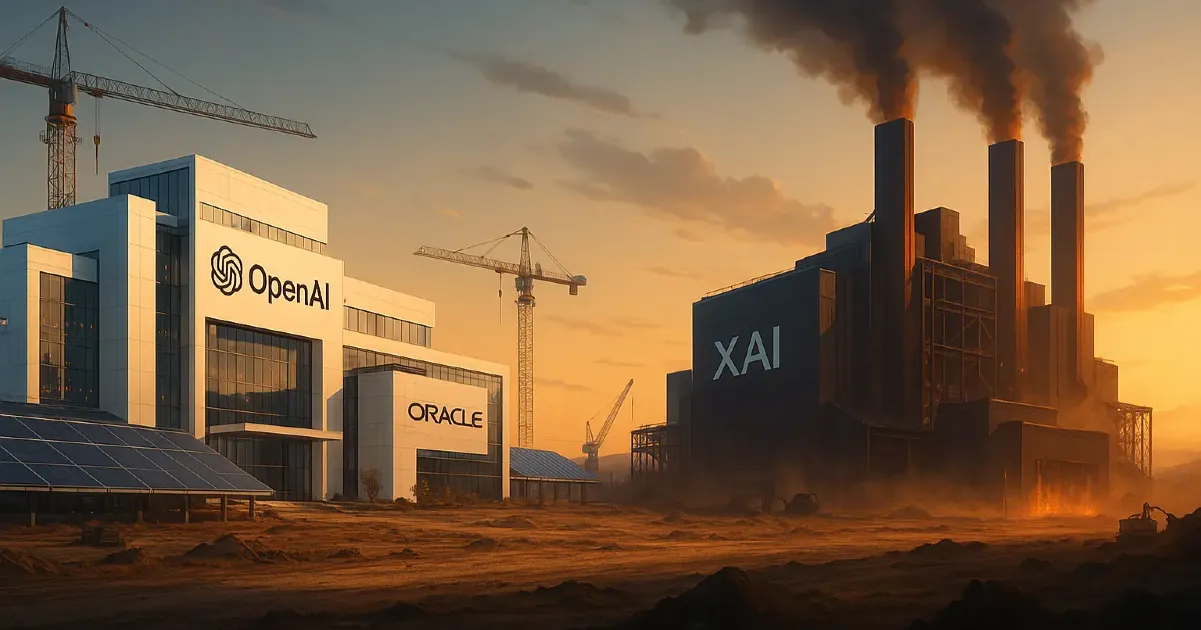OpenAI teams with Oracle to expand Stargate beyond 5 GW, while Elon Musk reveals a massive H100-scale vision for xAI over five years.
A New Arms Race in AI: Stargate Grows While Musk Unveils Bold Compute Plans
The future of artificial intelligence isn’t just about smarter algorithms anymore. It’s about energy, chips, and data centers, and the sheer scale of infrastructure being planned is enough to reshape how power is consumed in the 21st century.
OpenAI, in partnership with Oracle, is making an aggressive push to expand its Stargate project, already one of the most ambitious AI infrastructure initiatives in the world. The new announcement reveals an additional 4.5 gigawatts (GW) of compute capacity to be developed, propelling the Stargate ecosystem past the 5 GW threshold. That’s enough to power over 2 million AI chips.
At the same time, Elon Musk, never one to be overshadowed, revealed an even more audacious plan for his AI venture, xAI. Musk’s goal? Deploy AI infrastructure on the scale of 50 million NVIDIA H100-equivalent units within five years, an order of magnitude leap from today’s largest clusters.
It’s no longer just a race to build better AI models. It’s a race to build the infrastructure to run them at a global scale.
Stargate’s Expansion: A New Benchmark in Compute Power
OpenAI’s CEO Sam Altman took to X (formerly Twitter) to reveal the expanded deal with Oracle, which adds 4.5 GW of power to the Stargate roadmap. This move builds upon the original $500 billion commitment Altman unveiled earlier in 2025 at the White House, a plan that already aimed to redefine the scale and scope of AI infrastructure in the U.S.
“This is a gigantic infrastructure project,” Altman stated, sharing satellite imagery of the growing Abilene, Texas site, where Stargate’s first facility, Stargate I, is already underway. That site alone is expected to bring over 1 million GPUs online by the end of 2025.
Now, with the Oracle expansion, the Stargate development pipeline has surged past 5 GW, setting the stage for over 2 million chips to be deployed. Altman wasn’t shy about the longer-term ambition: “We are planning to significantly expand the ambitions of Stargate past the $500 billion commitment,” he wrote.
And while the infrastructure is massive, so is the purpose. OpenAI and its partners envision Stargate as the core of America’s AI backbone, a decentralized network of hyperscale data centers powered by clean energy and built to support the AI boom for decades to come.
Enter Musk: xAI’s Plan to Eclipse the Present
Not to be outdone, Elon Musk dropped a bombshell of his own. In a post on X, the Tesla and SpaceX founder unveiled xAI’s vision to bring 50 million H100-equivalent AI compute units online within five years.
To put that in perspective, today’s most powerful AI clusters, like the ones at Google or Meta, house between 10,000 and 100,000 H100s. Musk’s plan would multiply that scale by 500x, according to community calculations.
One analyst on X, posting under the handle TeslaPrice, explained that xAI’s current supercomputer, Colossus 2, is already set to include 550,000 GB200 chips, equal to 5.5 million H100s. But Musk wants to go 10 times beyond that.
“The goal is 50 million units,” Musk wrote. “With significantly better power efficiency than today’s H100s.”
It’s not just a technical vision. It’s a challenge to the rest of the AI world and a signal that Musk’s xAI is aiming to become a direct competitor to OpenAI, Google DeepMind, and Anthropic at an unprecedented scale.
Stargate: Born of a Government-Backed Initiative
Stargate isn’t a purely private endeavor. The concept was first introduced earlier this year as part of a broader AI industrial policy vision supported by U.S. President Donald Trump. The federal government gave a green light to a $500 billion public-private AI infrastructure roadmap, led by OpenAI, Oracle, and Japanese tech giant SoftBank.
The goal? Build state-of-the-art AI data centers across America, create 100,000+ jobs, and ensure that the United States doesn’t fall behind in the global AI arms race.
But reality hasn’t been smooth.
According to a Wall Street Journal report, Stargate has already hit significant roadblocks: delays in construction, disagreements between key stakeholders, and uncertainty about initial deliverables. Despite initial promises to deploy $100 billion immediately, only one data center may be operational by the end of 2025.
Nevertheless, OpenAI’s new Oracle-backed expansion suggests that momentum is still strong, even if timelines are shifting.
Why 5 GW of Power Matters in AI
To understand why 5 gigawatts of compute power is such a big deal, consider this: 1 GW is enough to power about 750,000 homes. So 5 GW? That’s like powering the entire city of Chicago all to run machine learning models.
Each GPU or AI accelerator chip consumes significant energy. When deployed in hyperscale clusters, rack after rack, warehouse after warehouse, the power needs quickly scale into the gigawatts.
The underlying compute will fuel everything from ChatGPT’s next generation to autonomous agents, simulation platforms, robotics, and perhaps AGI itself.
By partnering with Oracle, a major cloud player, OpenAI ensures it can manage the networking, power efficiency, and scalability required to actually bring this infrastructure online. Oracle, for its part, gains a front-row seat in the AI gold rush that has largely been dominated by Microsoft, Amazon, and Google.
Musk’s Counter-Vision: Scale Without Bureaucracy
While OpenAI moves forward with institutional partnerships and federal backing, Musk’s approach appears more independent, fast-paced, and controversial.
He’s already opened xAI to external developers and recently confirmed the Colossus 2 supercomputer will come online with 550,000 chips aimed at training Grok, xAI’s flagship AI model.
But going from 5 million H100s to 50 million? That’s not just about chips; it’s about land, power, and supply chains. Musk’s plan will require dramatic expansion of chip fabrication capacity, energy sourcing, and data center cooling tech, none of which are trivial.
Still, few would bet against him. Whether it’s Tesla’s Giga factories or SpaceX’s rocket production lines, Musk has consistently scaled hardware infrastructure at a pace unmatched in the private sector.
And now, he seems ready to do it again, this time in AI.
What's at Stake: The Future of AI Infrastructure
As both OpenAI and xAI pursue unprecedented compute goals, the broader implication is clear: the era of small-scale AI experimentation is over. What lies ahead is industrial-grade AI infrastructure spanning chips, energy grids, and sovereign-scale deployment strategies.
If Stargate succeeds, it could anchor the U.S. AI ecosystem and provide long-term resilience against foreign competition. If xAI delivers on its 50 million H100-equivalent dream, it may force every tech company and government to reassess its AI strategy.
Both visions are massive, but only one may win the timing game.
For now, OpenAI holds the lead in partnerships, infrastructure, and regulatory alignment. But Musk is betting on speed, scale, and power efficiency, and those three elements have disrupted industries before.





